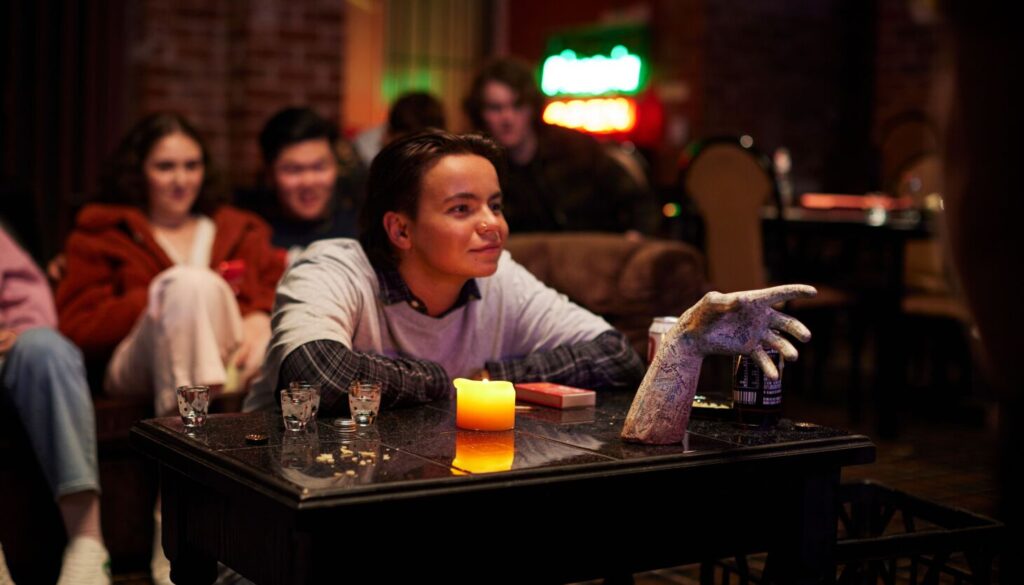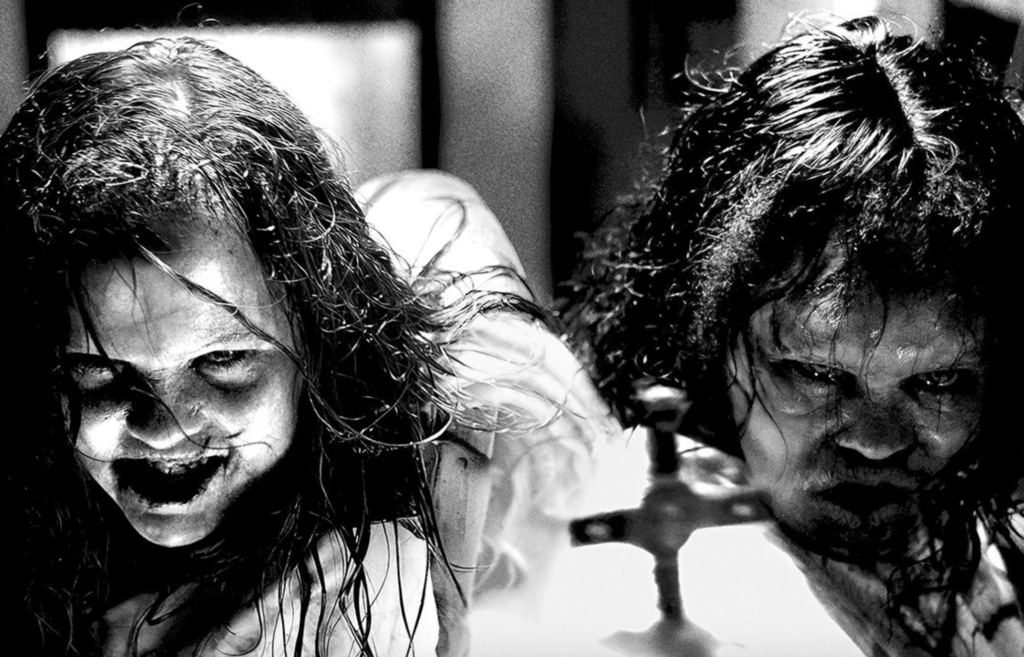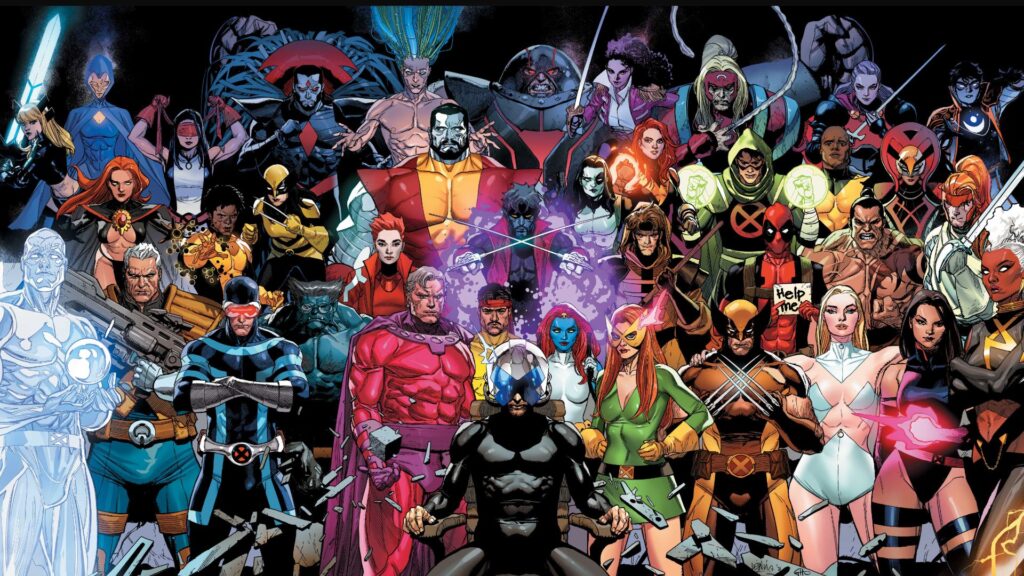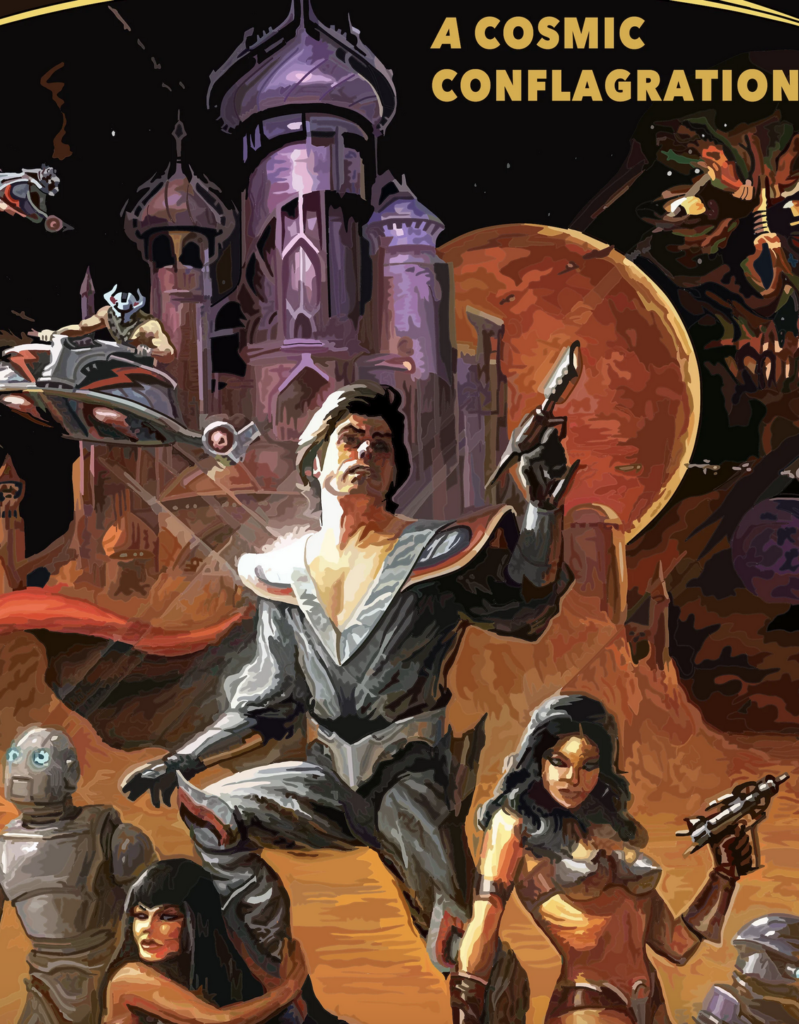
So I’m sitting there watching Talk to Me, the A24 Australian horror movie you might have seen the trailer for. It’s the one where a bunch of teenagers are in a basement and one of them holds a hand statue and then goes into some sort of trance.
The movie is pretty good. But it made its fair share of screenwriting errors. Basically, the plot goes like this. A teenage girl, Mia, hangs out with this family all the time because her mom died. She’s got her friend, Jade. And then Jade’s younger brother, Riley.
This trio occasionally hangs around a cool group at school, led by tough-chick Hayley, and Hayley’s muscle, Joss. This group loves to play this game called, “Talk to Me,” where they bring out a hand statue, strap you into a chair in front of it, you hold the hand and say, “Talk to me,” then follow that by saying, “I let you in.”
As soon as you say, “I let you in,” whoever’s in the chair sees a [usually gruesome] dead person sitting in front of them. Nobody else in the room can see this. Just the person in the chair. This creates a level of doubt where everyone can write the experience off as fake, much like when two people push the planchette on a Ouija board. You can always blame the other person as the pusher.
Except everyone in the room participates in the experience so that sort of negates the idea that they’re faking it. But we’re not going to nitpick.
Mia seems particularly affected by her experience, where she saw a couple of gnarly dead bodies. But it’s when Riley goes under that the crap hits the air conditioner. Riley is channeling Mia’s dead mother.
Mia is so taken by the chance to talk to her mom that she prevents Riley from stopping the experience before the mandatory 90 seconds. Riley starts going ballistic, bashing his head into anything he can find, nearly killing himself before they’re able to detach the hand from him.
This results in Mia being banished from the family, which sends her back home to hang out with her dad. When Mia sees her mother’s apparition again, she finally answers the question about whether she killed herself. She didn’t. And the person who did is two rooms away from her. Her father. Time to run.

You may have snooped out a couple of the screenwriting issues from that synopsis. The first is that the possession rule is shaky. In fact, we’re not even sure people are being possessed for three-quarters of the movie. Mia is not possessed despite going through the process. She sees other spirits, like her mom. But she’s not possessed.
Then, near the end, we lean heavily into the injured Riley being possessed. And then, of course, Mia’s father being possessed. Whoever’s inside of her dad is trying to kill her.
You can tell that the writers started to realize near the end of writing the screenplay that, “Oh, they’re possessed! So we can do something with that!” So then they rush to pay off a possession storyline that they never really set up.
It’s fine to do this. It’s a natural part of screenwriting. You figure things out while you’re writing the script. But once you figure something big out, you have to go back and properly set it up.
Ditto the dad. They didn’t even mention the dad for the first 70% of the movie! I didn’t know she had one. How could I? She was always at this other house. And the writers leaned heavily into this idea that this other family was taking care of Mia. So we assumed she didn’t have family.
To not only tell us she had family, but to build the crux of Mia’s entire storyline around what her father did to her mother was clunky to say the least. A good screenwriter is going to realize that if they want to use this ending, they need to go back into that first act and properly set up the dad. Then keep him in the story throughout the second act.
As I was pondering all this, a question popped into my brain: Does it matter? Or, more specifically, would this have mattered in regards to how well the movie did? It’s got a 94% critic score on Rotten Tomatoes. It’s got an 82% audience score. It made 50 million dollars in the U.S. and nearly 90 million worldwide.
Would making those changes have affected these numbers in a positive way? Because if you look just at the movie, it’s really well put together. The main actress who plays Mia, Sophie Wild, is great. She’s going to become a star. The rest of the cast is really good. There are no weak links.
The cinematography is great. The directing overall has no weaknesses (they were particularly convincing in creating a “teenage atmosphere”). Also, the hand sequence WORKS. Whatever it is at the center of your fantastical story, it has to be convincing for the viewer to suspend their disbelief. If it’s hokey or dumb, they’ll immediately check out. And the “talk to me” stuff was perfect.
Most importantly, the movie was scary. I did the thing where I put my arms up in front of my face half-a-dozen times cause I saw something weird in the corner and it started moving and I didn’t want to know what the f*** it was.
So, if you do those things: You have a convincing mythology, you have plenty of legitimate scares, you have characters who we’re on board with – you can make screenwriting mistakes and it be okay. It’s similar to what I tell comedy writers. If your script is funny, you can have the worst plot ever. It doesn’t matter. Ditto with horror. If it’s scary, you can make mistakes.
But the purist in me still believes that if you fix those mistakes, your movie is going to have better word-of-mouth which means more people are going to want to see it. I think it’s telling that the audience score is lower than the critical score here. Audiences may have been a little frustrated by the sloppiness in the storytelling.

Look no further than what happened to Exorcist: Believer this weekend. Now I didn’t see the film. But I knew that the baseline they were building predictions off of was 30 million. Because that’s what the predicted ROI was for this particular advertising package. Now, the box office could go well above that number or below it. And it depended on if the story was good.
Guess what?
It wasn’t good. It has a 22% Rotten Tomatoes score and a 59% Audience score (which will probably go down once more reviews come in). It was made clear early on on social media that this one was a stinker. And so all those potential moviegoers who were thinking about going on Saturday who were going to pump up that box office to the high 30s, maybe even 40 million dollars, they decided to stay home, and the movie made 27 million bucks.
In David Gordon Green’s defense, I’ve never been able to figure out the key difference between an exorcism movie that works and one that doesn’t. For all intents and purposes, the original Exorcist should not have worked. It’s long. We’re stuck in this house the whole time. Some characters disappear for 90% of the movie. Others show up halfway into the movie.
I just remember that movie feeling so real. It felt like how an actual exorcism situation would happen. That realism is what sold it for me. And even though all these exorcism movies since have given us convincing possession performances, none of them has felt as authentic as The Exorcist.
In other words, trying to recreate the authenticity of one of the most authentic horror movies ever is a hard task to pull off. None of the other Exorcist sequels have been able to do it. I’m shocked, like the rest of the industry, that Universal paid 400 million for the rights to try and change that pattern. A lot of people thought they were dumb. Believer’s critical and audience reception is proving them right. It looks like this franchise is going to end up on the bottom of a concrete stairway.
This is a friendly reminder to get those Horror and Thriller loglines in for the big Halloween competition. I am DETERMINED to find a great genre screenplay on this most wonderful of holidays. Keep’em coming!
What: Halloween Logline Showdown
Send me: Logline for either your Horror or Thriller script (Pilot scripts are okay!)
I need: The title, genre, and logline
Also: Your script must be written because I’ll be reviewing the winning entry the following week
When: Deadline is Thursday, October 19th, by 10:00pm Pacific Time
Send entries to: carsonreeves3@gmail.com

Reviewing “Seven” in my newsletter brought me back to a time when screenwriters could change their lives overnight. All they had to do was a write a good screenplay and – BOOM – they were millionaires.
Those sales then did double-duty for them, as their names would be splashed all over the trades. This would result in everyone in town wanting to meet with them. Which would establish contacts for these writers that they could use to write high-paying work for the next decade.
What happened to that world and how can we get it back?
A number of things happened. For starters, the internet screwed up the agency’s con. A big part of how scripts got sold in those days was that an agent would send a script out (hard copies, remember, not pdfs) to 7 studios and because all parties were isolated from one another, studios would freak out, afraid to lose a hot spec to a competitor, and therefore bid on that script out of fear, regardless of it it was any good.
Once the internet arrived, Roy Lee, a producer now at Warner Brothers, created an online chat room where assistants could share their thoughts on scripts. Therefore, when a script went out this time, it got photocopied quickly and, within hours, everyone was reading it. These assistants now had a central location to share their thoughts on the script, which would allow a quick consensus on if a script sucked or not.
And here’s the open secret about agency-endorsed screenplays (both then and now) – most of them are bad. Now, that badness was being exposed. So that previous strategy of scaring studios into bidding on bad material didn’t work anymore. This killed a lot of sales that would’ve gone through in the previous era.
Another thing that happened was that the studios all agreed not to share sale numbers anymore. They did this because the news stories about scripts selling for 2 million dollars were driving up script prices. So if you stopped telling people how much a script sold for, the trades were less likely to write a big story about them. And this would allow the studios to bring script prices down to a reasonable level.
I still don’t understand why agents agreed to this. It’s in an agent’s best interest to promote a big spec sale because it will get their client more work as well as themselves more money. The conversation may be more nuanced. I know that, sometimes, a script would sell for a lot less than expected and, in those cases, the agents would want the script price to be vague. That way they could hint that it was bigger than it was.
But just the fact that the trades no longer posted these numbers hurt the script sale business immensely.
But now we get to the biggest reason spec script sales plummeted – THE SCRIPTS WERE BAD. Go ahead and read some of these old million dollars sale scripts. Or just go back through my archives. They’re in there. These scripts were average at best. And so, when they got made, they didn’t make enough money. And when that happened enough times, the studios said, “We’re not following that carrot anymore. We know where that carrot leads.”
The inflection point was 2014’s Transcendence, with Johnny Depp. That was a spec script. That was an expensive movie. And it just SAT THERE. Nothing happened in that screenplay (which I erroneously gave a decent review to). So nobody showed up. And I specifically remember the drop-off of script purchases that occurred after that movie’s first weekend. And the market never recovered.
Which leads us to the post’s big question: How do we bring spec script sales back?
For one, trades have to write about them again. One of the reasons spec scripts became so big in the first place was all the stories that the trades would write about them. If someone sold a big spec, there’d be a giant Variety article that would go into detail about the writer – where he came from, how he conceived of the idea. It was exciting! I still remember reading that article about those valet guys who wrote a spec about valets that made a million bucks. Those stories drive interest in screenwriting. We need them. And nobody writes them anymore.
I’ve thought about writing them myself. But there is some conflict-of-interest. When I have made some calls to get info and developed relationships with those buyers in the past, it would get complicated when I would then have to review the script (or another script from the same production company). I’d notice that I was a little easier on the material than I would normally be. But it’s something I should consider because that sacrifice could be worth the industry having a place where they can consistently read the latest screenwriting success story. Let me know in the comments if you think I should do this. It might mean not being able to review those scripts, though.
We need to publish script sale numbers again. Agents and managers should be promoting those numbers like crazy. It’ll lead to their clients making more money on future projects! Which means more money for them! I don’t care if these spec sale prices are low at first (250 grand, 350 grand). They will grow over time if we keep our foot on the gas and keep writing about these sales.
But the biggest thing you, the writers, need to do is write THE RIGHT SCREENPLAYS and then do a GREAT JOB WRITING THEM. These scripts don’t only have to be as good as the mega-franchise movies. They have to be better. Cause they don’t have any IP behind them. So if you’re a studio taking a chance on one of these scripts, the script has to be really impressive.
Ever since the spec sale business died, the primary measuring stick for a screenplay has been The Black List. And The Black List has become the opposite of the spec sale business. It’s become the Nicholl Fellowship List. It promotes intellectual screenplays over commercial screenplays. It still serves the purpose of getting writers recognized. But it doesn’t help the spec sale trade at all.
To revive the spec sale trade, you have to start with the kind of movie template that actually makes money. Former spec script mainstays like Comedy (The Hangover), Dark Thrillers (Silence of the Lambs), Romantic Thrillers (Fatal Attraction), and Romantic Comedies (Notting Hill), have been relegated to streaming services. Which means you can still make money off of them. But it’s not going to be for a big paycheck.
The movies that spec writers can still write these days and realistically sell for big money include the Action movie (Beekeeper), Action Comedy (Spy), Horror (Us), Buddy Cop movies (Central Intelligence), Guy/Girl with a Gun movies (John Wick), Fun Slasher movies (Scream), Heist (Ocean’s 11), Biopics (Elvis), Based on a true story World War 2 movies (Saving Private Ryan), Contained Thrillers (The Mist), Fun Undercover Cop movies (the original Fast and Furious, Point Blank), Ensemble Big Concept (Knives Out) and to some extent, the general high concept script, as long as it’s upbeat and therefore would sell a lot of tickets (think Jurassic Park or Free Guy).
This is not to rule out updating old templates, like the Submarine movie (Crimson Tide), the Action-Crime movie (Heat), Hitchcockian Suspense movies (Gone Girl), The John Carpenter movie (Escape from New York), The John Hughes movie (elevated teen fare), the big-budget Western (The Magnificent Seven), the pirate movie (Pirates of the Caribbean). Or just that bonkers wowza idea that’s never been done before.
To be honest, you could still write a rom-com that sells for a million bucks *if* you find a clever way to reinvent the genre. Actually, that’s the best way to sell any script for a million dollars. Reinvent the genre. Reinvent any of the movie-types I listed above and you can be a millionaire. I’m not kidding.
Once you’ve got your concept, the hard work begins. This is where the article comes full circle because “Seven,” in many ways, is the perfect spec script. It’s not only a clever idea. But it’s one of the few spec scripts I’ve read where it’s clear that the writer gave 100% on every page. There’s zero laziness in “Seven.”
The core reason that the spec boom died out was that the movies that resulted from those scripts didn’t consistently deliver. And that’s cause the scripts were weak. Most of the value in those scripts was concentrated in the first act. Which meant audiences would go to the theater, enjoy the heck out of the first 30 minutes of the movie, then became increasingly bored with every passing ten minutes. They’d leave the theater with zero energy and wouldn’t recommend the movie to anyone.
So if you want to revive big spec sales, it’s up to you guys. It’s up to you as to how much you want to work on your screenplays. This is why I tell writers, field-test your concept so you know it’s good. Cause if you do that, you know you can spend a year making your script perfect (e-mail me at carsonreeves1@gmail.com – $25 for a logline eval). Cause you already know people are going to want to read it whenever you finish.
Then, get feedback after each draft (figure at least six drafts)! Figure out which characters aren’t working. Make them better. Figure out where readers are losing interest then upgrade the plot in those areas. Even out your tone with each successive rewrite. Stay open to new exciting directions you can take your screenplay, even if it means extending your original deadline. Your goal should be to write something where you can honestly say, “I can’t make this any better.”
The thing you will never be able to control is writing an objectively great screenplay. You just never know how people are going to react to a story. But what you can control is writing the best possible screenplay YOU’RE CAPABLE OF WRITING IN THIS MOMENT IN TIME. I felt that way with “Seven.” I don’t feel that with many other scripts I read.
Let’s change that.
Then let’s sell some damn million dollar scripts.
Genre: Superhero
Premise: Both the X-Men and the evil “Brotherhood” fight one another in an attempt to lure Wolverine onto their side, while the Brotherhood’s leader, Magneto, plans a secret takeover of a major U.S. city, all amongst the country’s growing resistance towards mutants.
About: There’s been a lot of chatter over the last week about the “X-Men” writing job. Kevin Feige has said he’s ready to go. So every big screenwriting name in town is going to pitch for the job. In 1997, Andrew Kevin Walker, the writer of “Seven” (and the upcoming, “The Killer”) wrote an X-Men movie. We’ve got a reader here on the site who says it’s the best X-Men script ever written. Today we’re going to find out if that’s true.
Writer: Andrew Kevin Walker
Details: 152 pages

Not a lot of people know what I’m about to tell you but YA BOY used to love X-Men comics. In fact, they were the only comics I liked. I just loved that name: “X-Men.” So cool. And the fact that there were so many of these guys! It felt like every time you opened the comic, you would meet a new X-Man. Why buy Superman and hang out with one superhero when you could buy X-Men and hang out with a hundred of them?
This X-Men love probably would’ve continued well into adulthood. But in 7th grade, I discovered girls. After that I wasn’t too interested in comic books. Or anything that wasn’t girls for that matter. Still, I always had a soft spot for X-Men.
When X-Men finally made it to the big screen via Bryan Singer, it was a letdown. I thought the costume and make-up were second-rate. The production value had an almost “video” quality to it. The casting was hit or miss. The only good X-Men movie that came out of that franchise was X-Men: First Class. Otherwise, it was a waste of good IP.
That brings us to today. This tattered franchise is not only trying to reinvent itself. It’s trying to revive Marvel. Marvel is a Capital-J Joke right now. Every one of their movies gets worse and they’re about to experience an all-time low with The Marvels.
X-Men is the first time in a long time where they can introduce beloved known characters into the Marvel Universe. If they can pull this off, it could be Iron Man all over again – meaning a foundation you can build the entire next stage of the Marvel franchise on top of. And, unlike Iron Man, you’ve got tons of characters to work with instead of just one.
Now, I don’t know about you. But if I had a chance to grab the 1997 version of the screenwriter who wrote Seven to script my X-Men movie, I would take it. Well, guess what? Andrew Kevin Walker *did* write an X-Men script. Does this mean that Kevin Feige doesn’t even need to hire a writer anymore? Does he already have a great X-Men script in his possession? Let’s find out!
A war is a brewin’. It’s a 3-way war. Team One is the X-Men, the good mutants. Team Two is the Brotherhood, the bad mutants. And Team Three is the government. They want to tag every mutant by having them register via the Mutant Registration Act.
The Three-Way War is complicated by the fact that the X-Men and the Brotherhood need each other. They’re all mutants and the government wants to take them down. But with Magneto running the Brotherhood, Xavier knows that there’s no way they can work together. Magneto’s a bad dude. He’s even responsible for putting Xavier in that wheelchair he rolls around in!
Right now, the X-Men and Brotherhood are each trying to retain the services of the top mutant free agent, a guy you may have heard of. His name is Wolverine. Wolverine wants to be left alone but since Xavier seems so sweet, Wolverine joins Team X-Men, and quickly gets into a love triangle with Jean Grey and Cyclops.
But when no one else is around, Wolverine drops the tough guy act and struggles to remember how he became a lab rat and turned into a super killing machine. He eventually recruits Xavier and his psychic powers to go deeper into his memories. Xavier is shocked to find out, however, that not even he can penetrate Wolverine’s memories. There’s some sort of memory blocker inside of him – top level tech, which means someone REALLY DOESN’T WANT Wolverine finding out the truth.
When Xavier and friends least expect it, the government sends in giant “sentinel” robots to destroy his mansion. While this is happening, Magneto finally unleashes his secret plan. He uses the Brotherhood to flood all the tunnels in Manhattan and close all the bridges. He then goes on air and says Manhattan is now mutant land. All humans have to leave. It’ll be up to the X-Men to regroup from their attack and stop them.
The coolest thing that happens in this script is The Brotherhood taking over Manhattan. And you know what page that happens on? Page 110.
You could make the argument that that’s the perfect time to introduce the takeover since it’s the third act. But I would disagree with that. You need to have the takeover happen either at the first act turn or, ideally, the midpoint.
Cause it’s a way more interesting story once the bad guys take over the biggest city in the world. And they invite all these mutants in and it becomes a mutant stronghold. And now you have this fun story where the government, who previously hated the X-Men, has to come to them for help. Then the X-men go in there to save the day.
Instead, we get a Character Setup Fest. The very thing that I said was so cool about the X-Men — that there are so many of them — is what kills this screenplay. Normally, if you’re writing a superhero movie like Spiderman: Homecoming, you have to set up Peter Parker, you have to set up the Vulture. And you’re done! Now you can get to the fun stuff.
In X-Men, we have to set up The Blob, Beast, Sabertooth, Wolverine, Xavier, Jean Grey, Cyclops, Juggernaut, Angel, Iceman, Magneto, and Toad. Look up at that page count again. You see it? Read it back to me. 152 pages, right?
You’ve heard a million times you’re not allowed to write a script that long. So why is this 152 pages? BECAUSE THEY HAD TO SET UP SO MANY CHARACTERS. Think about it. All those characters I just listed. They each need a proper setup scene. That’s 3 pages each. That’s 35 pages right there. And that’s just their setup scene. You still have to give them follow-up scenes that explain their purpose in the story. You’re on page 50 before you’ve even mentioned a plot!
That’s how this script reads. I could feel Andrew Kevin Walker’s struggle. He had all these characters to set up before he could get to the New York stuff, so what he would do is he would set up five characters and then he’d have some action scene where Sabertooth would fight Wolverine. Then we’d do five more characters and we’d get a set piece where the government would attack the X-Men. You put those scenes there to entertain the reader in the midst of all this setup because it feels like it’s the only way to keep the audience’s attention. But the reality is, you needed to find a way to set everyone up faster so you could get us to that plot ASAP.
Look at Toy Story. Toy Story has just as many characters as X-Men. But Toy Story is under two hours. So what are they doing differently? What they’re doing is one of the things that the best writers get paid so much money for, which is to not only set up characters BUT TO SET THEM UP AS QUICKLY AS POSSIBLE and DO SO IN A WAY THAT THEY’RE INSTANTLY MEMORABLE.
So, with Toy Story, they set up the T-Rex with a quick little moment where he tries to roar but his roar is not scary and – BOOM – we’ve established his character in twenty seconds.
This script should be a cautionary tale for whichever writers get the new X-Men movie. Cause they’re going to face this exact same problem. Audiences need to feel like a big story is emerging in the first act of the movie. At the very least, we should know where it’s going 15 pages into the second act. With this movie, I didn’t know where it was going until the third act started. You can’t do that.
Script link: The X-Men
[ ] What the hell did I just read?
[x] wasn’t for me
[ ] worth the read
[ ] impressive
[ ] genius
What I learned: Wherever your main plot points happen in your screenplay, there’s a good chance you can move them up earlier. Especially if it’s an early draft you’re working on. We tend to delay our big plot points in early drafts.
Genre: Sci-Fi
Premise: A rag-tag group of space pirates come together to travel to a mysterious planet to retrieve a technology that will help them defeat the alien presence that has annihilated earth.
About: Tab Murphy was rolling in 1996. He had just come out with the huge Disney hit, The Hunchback of Notre Dame. He was writing what would become another Disney hit, in Tarzan. So he was poised to take a big step in his career by writing a Star Wars like movie, something with the potential to break out and become a massive box office phenomenon. Unfortunately, like many projects in Hollywood, it never made it to the finish line. But for a writer who not many people have heard of, Murphy has had that rare longevity in his screenwriting career. He’s still writing today!
Writer: Tab Murphy
Details: 126 pages – Sept. 10, 1997 draft

I’m in denial.
I feel like an alcoholic who swears that, starting tomorrow, I’m going to stop drinking.
I’m pretending like Star Wars still has a future even though everything about what’s happening with the franchise tells me we’re in a late-stage civilization collapse. It’s gotten to the point where we’re hanging our hopes on George Lucas’s teacher’s pet, who still believes the prequels were the pinnacle of Star Wars.
A tear falls sullenly down my cheek.
The prequels??
Do I have to remind you how bad the prequels were? They were bad, people! They had a Jamaican lizard and a five-year-old who could race a flying vehicle 400 mph.
A second tear trails.
Whereas, before, there was always one Star Wars project you could hold out hope for that was going to change the franchise’s fortunes, we don’t even have that anymore. Star Wars’s big promise, at the moment, is a Rey movie.
Full on weeping at this point.
So I always like to check out what else is going on in the sci-fi fantasy space. Maybe there’s a new Star Wars franchise itching to come to life. I’d never heard of Star Blazers. I’ve never heard of Tab Murphy (or his sidekick, CapsLock Olsen). So I have no idea what I’m getting into.
The year is 2098. The earth has been defeated by the Gamelons, a human-like species that has destroyed many a planet in the galaxy. There remain small pockets of resistance, one of which resides in caves behind, yes you’re about to read this right, Mount Rushmore.
20-something brothers Derrick and Alex are the best pilots left on earth and are pretty snazzy when it comes to dispatching the latest Gamelon attack. But when Alex heads off on a mission that goes very badly (“It’s a trap!”), he extends his last flap.
Brother Derrick is devastated. But his mourning is cut short when their radar notes a strange ship that has landed in the mostly-blown-up city of Chicago. Derrick shoots over there, finds the ship, and discovers a robot lady inside. He grabs her and takes her back to Mount Rushmore.
Once back at Mount Rushmore, robot lady sheds her skin and becomes… an alien lady! Whaaaaaaat??? She explains to the humans that she has a special technology back on her planet that will help the humans defeat the Gamelons. “But we don’t have a ship?” Derrick says. “We do, actually,” his superior says. The USS Arizona! Yes, they retrofitted one of their aircraft carriers to become a spaceship.
But now they need a crew! The only crew they have is a bunch of pirates who led a mutiny against their last captain. Welp, beggars can’t be choosers! They all jump on the ship and shoot out into space. Along the way, Robot Chick slash Alien Chick then transforms into ANOTHER person. She’s actually a Gamelon! Whaaaaaaaaat???
She tells Derrick not to freak out. She hates how violent her species is and still wants to help him. But now the goal has become more complicated. Ya see, we’re headed to Planet Gamelon, which means you guys are going to have to walk right through the planet to steal the special technology that will win the war. Will Derrick and the Pirates (sounds like a great 80s band name) be able to pull that off? We shall see.
Now, if you’re anything like me, you read that summary and you think, “That sounds like the dumbest movie ever.” But let’s be real here. If I summarized Star Wars for the first time to you, you’d think that was a dumb idea too.
So is Star Blazers the next Star Wars?
If by “the next Star Wars,” you mean the red-headed stepchild who’s allergic to everything and has just been diagnosed with sickle-cell anemia? Then yes.
As tempting as it is to just roast this thing like a Hawaiin pig, I want people to actually learn something here so let’s learn something.
You can’t start the adventure of your story at the midpoint. It’s just too late. And I’m not even allowing the year this was written to impede on this rule. Raiders of the Lost Ark came out 15 years before this script and Indy was off on his journey by minute 25.
So to not head into space until page 60 is a script killer. For two reasons. One, we feel like we’ve wasted too much time dicking around on earth attempting to find our story. And two, once we’re on our journey, we’re forced to truncate it, since we only have half a movie to explore it.
The journey – the adventure – needs to be your entire second act. That’s what second acts are for.
Okay, now for some roasting. Halfway to their destination, our team has to stop at another planet for refueling or something. And we meet the aliens on this planet and guess what they look like? Insects. INSECTS! Even back in 1997 this was the most cliche most obvious choice for aliens you could’ve gone with. You have to come up with something unique.
Because, if I had to guess why this movie wasn’t made – and I’m going to extrapolate this to represent all big budget screenplays that weren’t able to get made – the most likely reason is that you haven’t given us that one big thing that sets your script apart from all the other scripts out there. There isn’t a single original idea in this script.
And, sadly, that’s the case for most screenplays. The writers don’t ask that question and then wonder why nobody e-mails them back after reading their script. It’s because you’re not bringing anything new, or original, or fresh to the table. Insect aliens? Your 7-year-old son could’ve come up with that idea. So why are you using it? You’re supposed to be the professional, the guy who comes up with ideas the average person cannot.
But what it really comes to – and this is how Star Wars separated itself – is the characters. We have to love and care about the characters. And every character in this script was so basic and formulaic and cliche and thin. Derrick has a “save the cat” scene early on where he kisses his little sister and tells her everything’s going to be okay. Again, it’s as if someone writing a 7th grade short story came up with that choice. That’s how on-the-nose and common it is. It doesn’t feel like the writer is even trying.
That’s what drives me the most crazy. When I can tell that the writer isn’t trying their hardest. It is soooooooooooo hard to write something good EVEN WHEN YOU’RE PUTTING EVERY OUNCE OF YOURSELF INTO IT. So how likely do you think it is that you’re going to write something good by half-assing it?
I’ll give you a hint. About as likely as me watching the final episode of Ahsoka.
The good news is, you guys can form your own opinions. Here’s a link to the script!
Script link: Star Blazers
[ ] What the hell did I just read?
[x] wasn’t for me
[ ] worth the read
[ ] impressive
[ ] genius
What I learned: Beware “fake humor.” Oh boy. I can’t stand fake humor. Fake humor is when you have your character say something that’s not actually funny but presents itself as funny and, as such, gets a polite laugh form the audience. So, when Derrick and crew first show up to the Gamelon planet, they see that the whole planet is a city (another cliché). When Derrick sees this, he says, “No wonder you people conquer other planets. You’ve run out of parking spaces.” This line is the definition of fake humor. The writer is not actually trying to make anyone laugh. He’s merely presenting a line that is designed to be laughed at. Please, for the love of all that is Bib Fortuna, don’t use fake humor in your scripts. Use real humor.


